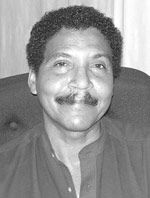Dr. Earle Kirby – A remarkable life

by Paul Lewis
The Historical and Archaeological Society of St.Vincent and the Grenadines mourns the loss of Dr. Ian Ayrton Earle Kirby, a fine public servant and remarkable researcher. Born in 1921 to Otto and Olive Kirby, young Earle attended the Intermediate High School before transferring to the St. Vincent Grammar School where, by all contemporary accounts, he excelled well enough to be presented as a candidate for the Annual Island Scholarship Examination. {{more}}
During World War II Dr. Kirby attended the Imperial College of Tropical Agriculture in Trinidad before moving on to Guelph University in Canada where he qualified in veternarian medicine. For many years Earle Kirby worked in the Agriculture Department as a veterinarian officer, and later acted as Chief Agricultural officer. However his official duties stimulated a latent interest in archaeology and the story of our indigenous peoples, the Kalinagos and Garifuna.
While Kirby was a veternarian by training he became an archaeologist by choice. From his field trips he brought back not only the results of his interventions on the farms or experimental stations, but Amerindian artifacts of all sorts that he just happened upon, or items he had deliberately set out to investigate as a result of previous “discoveries.”
By the early 1970s he was doing significant research in Archaeology as reflected in his first publication The Pre-historic Monuments in Stone (1969). This began a long and most fruitful exploration into the field of Archaeology and the history of the indigenous peoples of St.Vincent. By1972 he had assisted the research of Ripley K. Bullen and his wife when they worked in St.Vincent, and whose findings were presented in their Archaeological Investigations in St. Vincent and the Grenadines (1972). That same year he collaborated with Christian Martin to produce the first edition of The Rise and Fall of the Black Caribs of St.Vincent. This was followed in 1973 by a short catalogue on The Sugar Mills of St.Vincent- Their Sites.
Earle Kirby soon established himself as one of the leading archaeologists in the Caribbean. Though not professionally trained, he quickly gained the respect of his colleagues, mostly university-trained archaeologists. As with all scholars, his peers put his theories under close scrutiny but Kirby held his own magnificently. He won their respect, trust and support. He was a frequent contributor to annual conferences of the Association of Caribbean Archaeologists, now the International Association for Caribbean Archaeology (IACCA). Among his papers delivered at those conferences were: The pre-Columbian Stone Monuments (Grenada); The Cayo Pottery of St.Vincent â a Pre Caliviny Series (Antigua); The Pre-Hispanic peopling of the Antilles (Guadeloupe); A newly found petroglyphic rock on St. Vincent (Guadeloupe); Dr. Bullen and the Amateurs (Caracas); Some Notes of Interest to the Archaeology of the Antilles (Caracas); and with Janice Wall, A unique Barancoid pot-stand (Caracas). Attending those conferences allowed Earle Kirby to establish not only professional links but provided the perfect opportunities to begin collaborating with other Caribbean persons in the field of archaeology.
It was here that he developed a special relationship with Eric Branford and The Archaeological and Historical Society of Saint Lucia. He visited St. Lucia and participated in many of the society’s activities.
Dr. Kirby’s knowledge of Vincentian archaeology was extensive. And while he shared much of this knowledge with the professionals he was very helpful to ordinary Vincentians, students and young people in particular. I remember contacting him in 2000 to speak to a group of Grenadian primary school children who came to SVG under a unique âKids In Actionâ Programme. Dr. Kirby readily invited them to his home where he spoke to them at length on the Garifuna people. This was done even though he was becoming less and less mobile and was obviously limiting his contact with the public. But he was extremely generous with his time and expertise, and he loaned personal books to many visitors to his home. Unfortunately some forgot to return those books. He was also very helpful to visiting scholars, and as a measure of their respect for him many often visited whenever they came to St.Vincent and the Grenadines.
In the mid 1960s, Earle Kirby along with Ebenezer Duncan, T. M. Saunders, C.U Theobalds, J.L Eustace, C.V.O. Hadley, W.B.D. Jacobs, E.H.N. Laborde and H.W.Watson, became founding members of the former St. Vincent Archaeological and Historical Society. Later he became one of the pillars of the National Trust. He was also an environmentalist who scoffed at the idea of the construction of a Cross Country Road. I suspect, too, that had he been in better heath when the controversy between Disney and the Caribs of Dominica erupted in 2005 that he would have taken to task those who had attempted to vilify the indigenous people by perpetuating the myth of the Caribs as Cannibals or those who foolishly dismissed the issue as “just a movie”.
Earle Kirby was an outstanding Vincentian. He has made a tremendous contribution toward a better understanding of our more remote national past and has prepared the way for other Vincentians to expand on his work. He was the Father of Vincentian Archaeology. I believe that a fitting tribute to his work would be the naming of the First National Museum after him, and the placing of his bust alongside the artifacts associated with his work. Finally, two scholarships in Archaeology should be awarded to individuals who would carry on his work.









